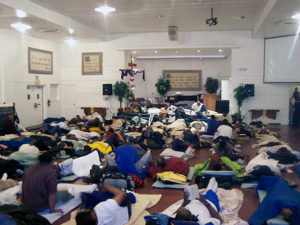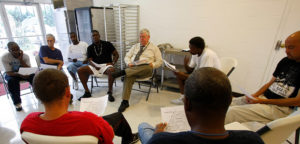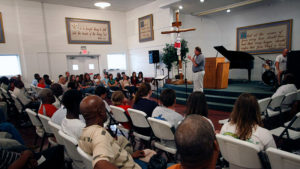Increased Demand for Services

The Mission continues to experience an increased demand for emergency services. At its 2020 fiscal year-end, the Mission sheltered an average of 304 individuals a day at its facilities, up from 234 in 2005. The increase in demand necessitated over 90 individuals a night sleeping on mats on the floor on average.
While the Mission’s services are in demand year-round, the demand is particularly acute during weather extremes. Both Memphis City and Shelby County governments rely on the Mission during weather extremes to provide safe shelter for homeless men, and the Mission is part of the Office of Emergency Preparedness’ winter contingency plan. On January 16, 2018, the Mission provided services for 460 overnight guests, illustrating the critical role the Mission plays in our community.
With the completion of Phase 1, the Memphis Union Mission has expanded its capacity by a total of 114 beds. Phase II has added an additional 112 beds, and when all three phases are complete, the Mission will have expanded its capacity to over 350 beds.
Facility Obsolescence
The Mission has continually operated its emergency shelter at its current location since 1960, 24 hours a day, seven days a week, 365 days a year. A local well-known architectural firm was retained to make recommendations regarding the facility. The conclusion was that 383 Poplar Ave. had reached its functional obsolescence.
The old facility’s aging infrastructure, especially its plumbing and HVAC systems, continually poses a maintenance challenge and an unneeded distraction from addressing guests’ needs. The facility’s age and outdated design make it difficult to adequately serve the growing number of disabled guests. The new Opportunity Center has been designed to meet the needs of an aging population and adequately serve our disabled guests.
The current facility’s lack of space constrains the Mission’s ability to provide some of the essential supportive services necessary to break the cycle of homelessness. Rather than providing symptomatic solutions, the Opportunity Center will be able to offer solutions to address the root cause of an individual’s homelessness.
Lack of Space for Supportive Services

The Mission’s old facility lacks dedicated space for supportive services that could help homeless individuals rebuild their lives and gain self-sufficiency.
The Mission hosts a few third-party supportive services within its existing facility. However, due to limited space, hosting them comes at the expense of providing other Mission services. Another challenge that the old facility poses is that it has no classroom space, making it nearly impossible for the Mission to provide literacy and educational classes.
With the completion of Phase 1, however, our new Center provides recovery program areas, including a classroom and counseling offices.
Upon the completion of Phase 3, the Opportunity Center will include a supportive services wing, which will provide for medical, educational, case management, and other important services to assist guests in breaking the cycle of homelessness and poverty.
Dining and Worship Limitations

The old facility’s multi-purpose room is too small to accommodate all of the Mission’s guests, particularly during weather extremes or during holiday meals. In these instances, overflow seating has to be set up in the lobby and other common areas, and the building can become highly congested.
Phase 1 has expanded the dining area to feed over 200 at a time. We are embarking on Phase 2, which will address worship limitations with a dedicated multi-use auditorium/chapel, with seating for 350+ guests and volunteers, two pastoral offices, and a prayer room.